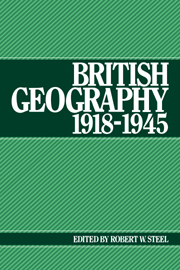Book contents
- Frontmatter
- Contents
- Preface
- 1 The beginning and the end
- 2 Geography during the inter-war years
- 3 Geography in the University of Wales, 1918–1948
- 4 Geography at Birkbeck College, University of London, with particular reference to J. F. Unstead and E. G. R. Taylor
- 5 The Oxford School of Geography
- 6 Geography in the Joint School (London School of Economics and King's College)
- 7 Geography in a University College (Nottingham)
- 8 Geographers and their involvement in planning
- 9 On the writing of historical geography, 1918–1945
- 10 Physical geography in the universities, 1918–1945
- 11 Geographers and geomorphology in Britain between the wars
- 12 British geography, 1918–1945: a personal perspective
- Index
2 - Geography during the inter-war years
Published online by Cambridge University Press: 07 October 2009
- Frontmatter
- Contents
- Preface
- 1 The beginning and the end
- 2 Geography during the inter-war years
- 3 Geography in the University of Wales, 1918–1948
- 4 Geography at Birkbeck College, University of London, with particular reference to J. F. Unstead and E. G. R. Taylor
- 5 The Oxford School of Geography
- 6 Geography in the Joint School (London School of Economics and King's College)
- 7 Geography in a University College (Nottingham)
- 8 Geographers and their involvement in planning
- 9 On the writing of historical geography, 1918–1945
- 10 Physical geography in the universities, 1918–1945
- 11 Geographers and geomorphology in Britain between the wars
- 12 British geography, 1918–1945: a personal perspective
- Index
Summary
‘Far be it from me,’ wrote H. J. Fleure in 1916, ‘to think of suggesting an Act of Uniformity as regards geographical method … the adaptability of the subject to the teacher's talents and opportunities is greater than that of most subjects …’ (Fleure 1915–16). He was writing at a time when education in general, and university education in particular, was apparently static through the misery of war but was about to experience a vast expansion, especially in secondary schools and universities. For all this the foundation had been laid in the new grammar schools and in the small departments of geography and other supposedly ‘new’ subjects. The advance was to come when Honours courses were provided, of which the first was at Liverpool in 1917 in the Arts faculty, followed a year later at Aberystwyth, in geography and anthropology, in both the Arts and Science faculties, and also in London in 1918, and by Cambridge and Leeds in 1919. No directive was given from government or from any national organization of geographers on the content of courses, so it is hardly surprising that they were largely a reflection of the views and tastes of the geographers who had become heads of departments, mostly working with one or two junior colleagues whose work in some cases was supplemented by courses given in other departments such as physical geography by geologists or the history of ancient geography by classical scholars.
- Type
- Chapter
- Information
- British Geography 1918–1945 , pp. 9 - 24Publisher: Cambridge University PressPrint publication year: 1987
- 1
- Cited by



